Remembering the Remarkable ’79 UCSB Gauchos—NCAA Men’s Water Polo Champs
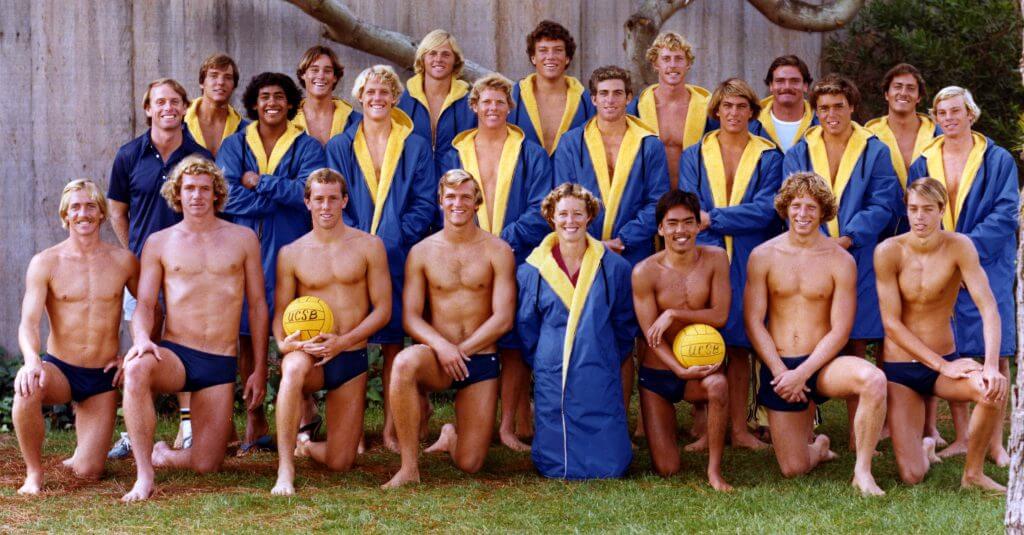
Did anyone foresee the surprising success of the University of California Santa Barbara’s men’s water polo varsity, 2019 edition? Ranked #7 in NCAA preseason polls, Coach Wolf Wigo’s Gauchos broke out of the gates with 15 straight victories, including wins over California, USC and Stanford, and for a time enjoyed a #1 ranking before a series of losses brought them back to earth and their current #4 slot.
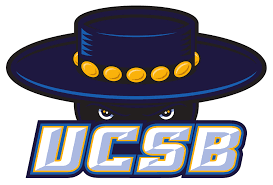 But this program is no stranger to success. Forty years ago, on November 25, 1979, the UCSB men’s water polo team won the school’s first-ever NCAA championship in Long Beach, California at the historic Belmont Plaza Olympic Pool in only the 11th edition of the NCAA championship tournament.
But this program is no stranger to success. Forty years ago, on November 25, 1979, the UCSB men’s water polo team won the school’s first-ever NCAA championship in Long Beach, California at the historic Belmont Plaza Olympic Pool in only the 11th edition of the NCAA championship tournament.
[UC Santa Barbara Aims to Replicate Gauchos’ 1979 NCAA Championship Run]
Its roster was, in then-third-year head coach Pete Snyder’s words, a unique collection of junior college transfers, four-year starters, redshirts, and a walk-on (!) first team All-American goalie. Anchored by four-year starter Greg Boyer, named the championship tournament MVP, as well as co-captain John “Spanky” Dobrott and goalie Craig Wilson (both of whom joined Boyer on the all-tournament 1st team), they compiled a program-best .903 winning percentage with a record of 28-2-1, while setting a still-standing school record for scoring in a season with 366 goals. The embarrassment of riches also included Guy Baker, a future NCAA championship coach and Women’s National team coach; Aaron Chaney, a future championship high school coach and Olympic referee; and several other All-Americans in Mike Yates, Dave Hendrickson, Steve Mitchell, and Dave Phillips.
Just Who Were Those Guys?
Snyder explained that compiling this team was a multi-year effort. Crafting a championship caliber squad at UC Santa Barbara takes a different kind of recruiting effort, he recalled: “The 1979 team was a building process that didn’t just happen during the fall….You’ve got to build a critical mass of players…and that takes time. The type of kids that usually go to UCSB….It’s not like it has a huge athletic tradition…that you can point to the wall at all of our accolades for athletics.
“You have to find unique kids that fit the environment,” he added.
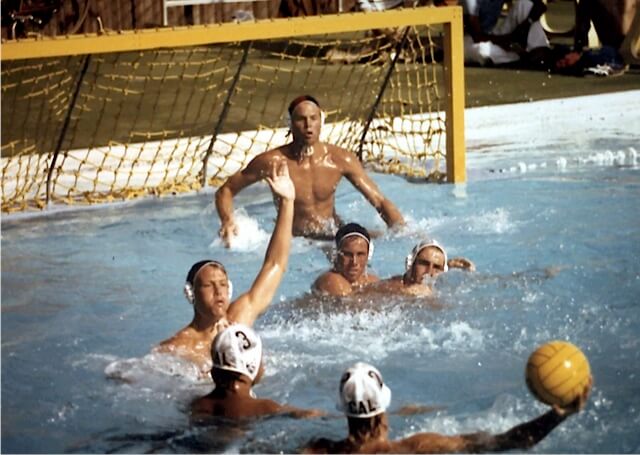
Craig Wilson defends his cage. Photo Courtesy: UCSB Athletics
Amidst the laid-back, beach city vibe of Santa Barbara’s Isla Vista, though, was a hardworking team, held accountable by both coach and players. Goalie Craig Wilson said: “Pete (Snyder), ran a very disciplined team, and there really wasn’t any opportunity to mess around.”
Wilson’s journey to UCSB was serendipitous. Growing up in Davis, he went to UC Davis his freshman year and played for the junior varsity. Looking to get away from home, he transferred to Santa Barbara City College and played two years there before walking on at UCSB. “I had met with Pete Snyder and said, ‘Hi, my name is Craig. I played water polo back in Davis High School. I’d love to try out for the team.’”
“I think we had five goalies at the time,” Wilson recalled, “and by the time we had our first game, Snyder announced the starting lineup, and … he said, ‘Wilson, you’re starting.’”
Snyder, in turn, remembered Wilson: “He was a diamond in the rough, you know?”
Spanky Dobrott also recalled that Wilson started slowly, but improved rapidly: “He was a little raw, but I often joke that the first week of practice with Craig, he could stop everything to the right but pretty much the rest of the cage was left open….Then the next week everything high right was gone. And a week later, nothing low left was going in.
“He just kept closing off the cage. You could see the talent, and also he was super-fast. He could throw the full length [of the pool]. He was the only goalie at the time who was getting assists. He had such a good arm. We got really lucky getting him.”
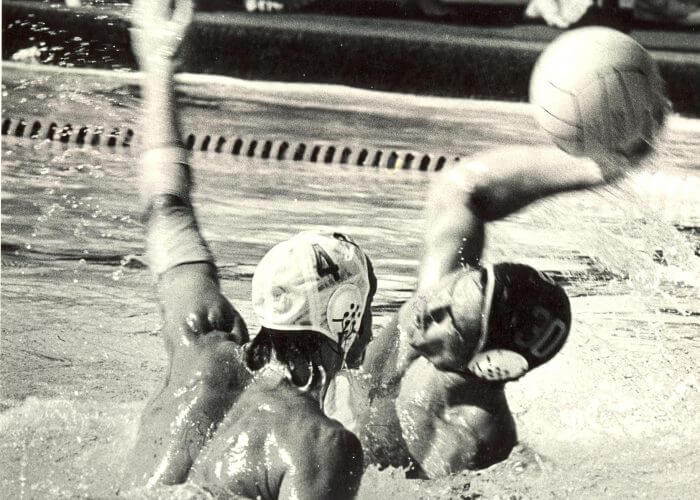
Dobrott with the shot. Photo Courtesy: John Dobrott
Dobrott had arrived on campus as a two-sport athlete in water polo and swimming from Newport Harbor High School. During his swimming career at UCSB, he set school records in the 200, 500, 1000, and 1650 freestyle. In polo, he tallied 214 goals in four seasons, currently fourth all-time at the school.
Greg Boyer led the high-scoring team with 68 goals, but that was only one dimension of his contribution. Snyder recounts, “He was very level-headed, pretty modest in many respects.” And, Snyder noted, “I will say this about Greg, he is without a doubt one of the most competitive people I’ve ever seen….Boyer would get in the water with Craig and just try to beat him. It helped Boyer because he’s going against this great goalie, and it helps Wilson because Boyer is trying to find his weaknesses.”
What DID They Accomplish?
During the ’79 regular season, the Gauchos started by beating all comers, except California, who eked out a 5-4 win in the sixth game of the season. From that point, they won 15 of their next 16 games, marred only by a 4-4 tie with Stanford (no overtime to break ties during the regular season in those days). A program record 12-game winning streak was ended by a late season 12-8 loss at Stanford. Following that game, UCSB completed the regular season with 6 victories and a 25-2-1 record.
Wilson thought that the loss to Stanford was a pivotal moment in the season: “It really got us focused as we went back to working out,” he said. “That was a really important game, and a really important loss.”
They entered the NCAA tournament as the third seed and faced Loyola-Chicago in the first round. At that time, the NCAA tournament format included eight teams and played off all spots in a championship and consolation bracket that traditionally ran over the three-day Thanksgiving weekend. True to their seed and talent, the Gauchos rang up 21 goals on Loyola’s Ramblers while surrendering only four and prepared for the semifinal game against Stanford.
Despite the previous regular season loss and a tie to the Cardinal, Coach Snyder was confident:
“Sometimes they [Stanford] were so good, but … they were young players at that point in time, and we were … loaded with seniors. So that experience helped. I just think that the guys emotionally were at a level where they felt they could beat Stanford.”
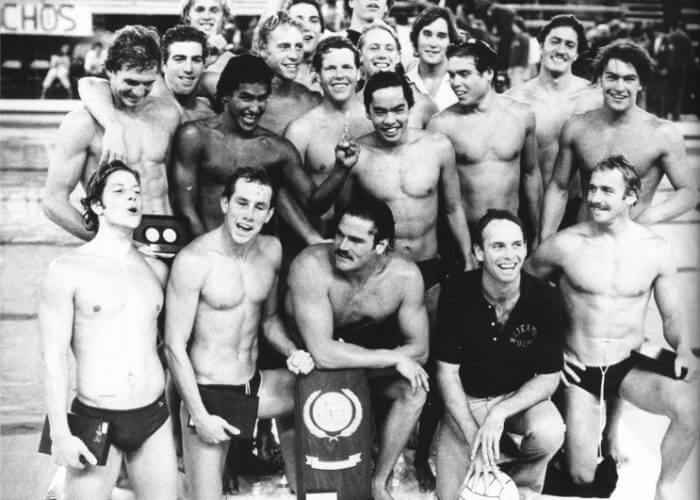
NCAA Champs! Photo Courtesy: UCSB Athletics
Wilson echoed that sentiment: “We were focused, and we were ready to go… [Stanford] was a wonderful team. We just played a notch better…we beat them fair and square by a goal.” (Wilson’s recall is spot on: the ’79 Stanford team included no fewer than six current and future All-Americans, three of whom went on to win Olympic medals for the USA. Five future USA Olympians played in that game, including Gauchos Boyer and Wilson.)
[On The Record with Pete Snyder, Head Coach for the 1979 UC Santa Barbara Men’s Water Polo Team]
The final score was 10-9, which, coincidentally, was the same score by which UCLA upset top seed California in the other semifinal. So, the finals would pit against the Gauchos against the UCLA Bruins.
The Final Match
Wilson recalled his feeling before the match: “I thought it would be my last game.”
Gaucho co-captain Dobrott was locked in: “I expected another tough game.”
But Snyder knew his team was primed and that their mindset was dead right for a championship game. “I think there is a subtle difference between being cocky, over-confident, and confident. That was definitely something that I tried to emphasize subtly. I never came out and said anything about the fact that this is UCLA….”
He reminded his team, “We’re pretty good ourselves. We need to show that. We need to be confident…but by the same token, I didn’t want them to get over-confident. I don’t think they were. There was enough on the line to where the edge was still there.”
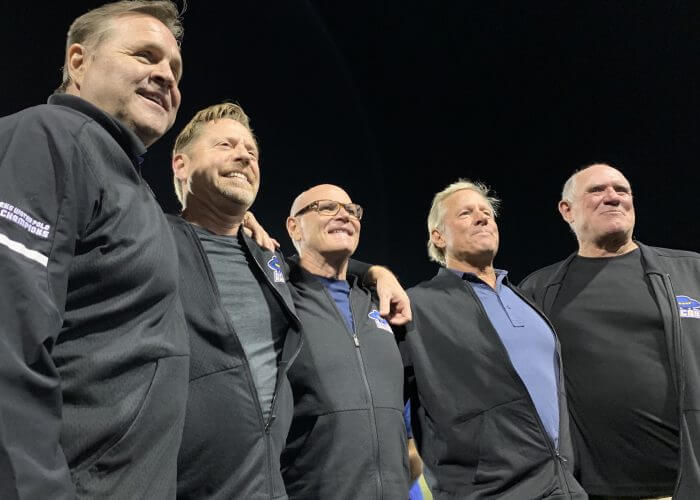
From left: Craig Wilson, Mike Yates, John Dobrott, Cam McBee, Greg Boyer.
The coach recalled his unusual preparation for the championship: “On game day I arranged to have us pile into one room at the Golden Sails Hotel in Long Beach, and spent probably a good three-four hours there. The guys were tired. They were getting psyched up. But I really felt in that room that everybody would contribute in some way, shape, or form. Football has the expression I love: ‘16 players hearts’ beating as one.’”
As it happened, the Gauchos stormed to an 11-3 victory, holding the Bruins under their school record of five-goals-against average while reaching just under the UCSB scoring record of 11.8 goals per game average. The wide margin of victory allowed Snyder to play everyone, including players such as Grady Howe and Aaron Chaney.
Dobrott thought it was a fitting tribute to both players: “When Aaron Chaney got in at the end, it was great. He came to practice each day and raised the level, and Grady Howe never complained and had the respect of his teammates.” (Chaney went on to become a successful high school coach at Iolani and Corona Del Mar and also rose to the level of a FINA official, culminating in an appearance at the 2004 Olympic Games in Athens.)
Where Are They Now?
Stanford graduate Pete Snyder coached the Gauchos through the 1993 season. While there, he earned his PhD in Educational Administration. He served as the Athletic Director at Fullerton College and remains active in polo as a college referee evaluator and volunteer coach at Santa Barbara City College.
Snyder and the squad forged a remarkable bond. In addition to the talent and depth of the roster, the group was tightly knit. Dobrott reflected on the importance of “Unity…we were a bunch of friends tied together socially”; and Wilson added that “the core of the team still plays Masters Club polo together, and won the 60+ World championships.”
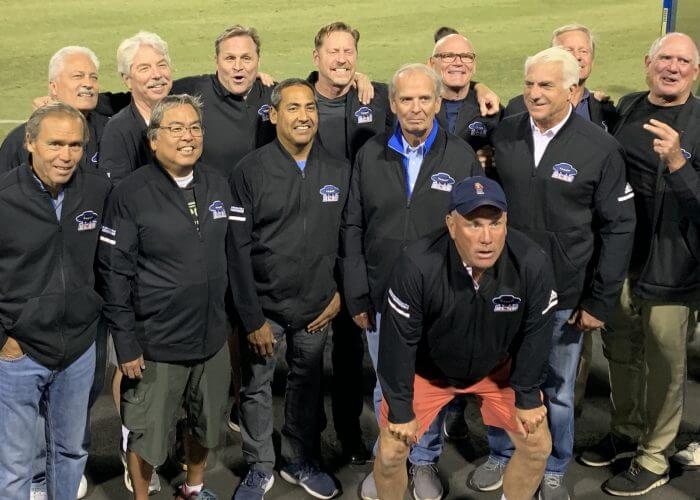
Forty years later the team returned in October to UC Santa Barbara. Back row l-r: Bob Anabel, Woody Lavayen, Dave Phillips, Craig Wilson, Mike Yates, John Dobrott, Cam McBee, Greg Boyer, Bob Mark. Front row l-r.: Aaron Chaney, Danny Katayama, Tom Candelaria, Pete Snyder, Brooks Bennett, Graham DeVries. Center front: David Hendrickson. Photo Courtesy: John Dobrott
Craig Wilson enjoyed a stellar post-graduate playing career which included three Olympic appearances where he earned two silver medals representing the U.S. in the ’84 and ’88 Games. He appeared in over 200 international tournaments from 1981 to 1992.
John Dobrott played on the U.S. National team in 1979-80, winning a Gold Medal at the World University Games. He completed his Economics degree at UC Irvine to qualify for training with the National team and has enjoyed a successful career in real estate development.
This championship group of student-athletes from UCSB won it all 40 years ago, and the team was recently honored at the campus pool by the UC Santa Barbara Athletic Department. The Gauchos’ last appearance in the NCAA tournament was in long-ago 1990, and, with a 18-5 record at this writing, the 2019 squad is hoping the anniversary will serve as inspiration for them as they aspire to another NCAA title.
1979 Men’s Water Polo Team
Won the 1979 NCAA Division I Championship…Team holds school records for highest winning percentage (.993), lowest goals against average (5.0), most wins (28), and most goals scored (366).
Team Members: Guy Baker, Brooks Bennett, Mark Bock, Greg Boyer, Tom Candelaria, Aaron Cheney, Graham Devries, John Dobrott, Dave Hendrickson, Grady Howe, Danny Katayama, Woody Lavayen, Bob Mark, Steve Mitchell, Peter Neushul, Dave Phillips, Joel Wade, Craig Wilson, Bill Yates, Mike Yates. Pete Snyder (head coach).
Special thanks to: John Dobrott, Pete Snyder, Craig Wilson




This story resonates for me on so many different levels. It’s a window back to a different time for NCAA polo, with the personalities on the Gauchos making for a compelling tale.
Not the least of which, wouldn’t it be fantastic if forty years after UCSB won a national championship, they might be in play for one this season?!
Bob Horne legendary Olympic and UCLA coach said of the Gauchos after the Bruins took a beating by the Gauchos in the Brentwood pool during 1979 season “Santa Barbara is the team to beat. They are the real deal”. And to that point we beat them 11-3 in the finals. It was a great year !
Go Gauchos,
You have always been the inspiration for all Gauchos continuing our careers post UCSB. Thus, no program is more widely represented in Masters Water Polo!!